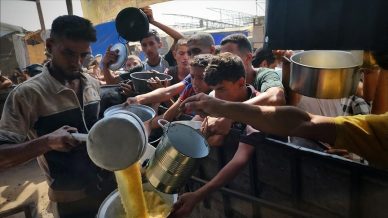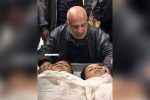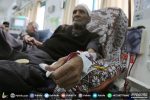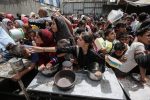GAZA, (PIC)
Students in the Gaza Strip have been cut off from schooling since the beginning of the current Israeli genocide, which is entering its sixth month, just about a month after the start of the first semester of the 2023-2024 academic year. According to the Palestinian Ministry of Education, 5,424 students have been martyred and 9,193 have been injured since the beginning of the Israeli aggression on Gaza and the West Bank on the seventh of October.
The ministry stated in a statement at the end of last month that the number of students who have been martyred in the Gaza Strip since the beginning of the aggression has reached more than 5,379, while the number of wounded has reached 8,888. Martyrs from the West Bank students reached 48, and the number of the wounded was 305, in addition to the arrest of 97.
The loss of the academic year
Students face the risk of losing the entire academic year as the war continues and a large number of schools and educational centers are lost due to direct Israeli targeting.
Mahmoud Matar, Assistant Minister of Education for Educational Affairs in Gaza, stated that “the academic year is at stake and its situation is linked to a decision to stop the war, and as long as this war and crimes against the Palestinian people continue, it is impossible to talk about the fate of the academic year or resuming studies.”
Matar confirmed that the ministry has developed a plan with many partners, including UNRWA and international institutions, which includes many scenarios for the fate of the academic year, but all are linked to the cessation of the war.
He explained that there are other factors preventing resumption, including the conditions of the schools, the lack of availability of textbooks, the psychological conditions of both teachers and students, in addition to many logistical issues. He emphasized that all of these are additional obstacles to resuming studies alongside the continuation of the war, which is the biggest obstacle.
He clarified that “after the war, there are several options to ensure that the academic year is not lost to the students, even if the war ends after a few weeks or long months,” pointing out that “the decision to resume studies is complex and there are many requirements for it to be made.”
He pointed out that “we have been in contact for months with many entities about the needs of the ministry and UNRWA to prepare schools or even places for learning, because the current conditions of the schools do not allow the resumption of studies in them immediately after the war. However, the plans in place allow for the resumption of the educational process after the war, even if partially.”
Regarding the numbers of martyrs among students and teachers, Matar affirmed that “we cannot yet count the numbers of martyrs, wounded, and detainees among the teachers and students, whether from the Ministry of Education or those affiliated with UNRWA and private schools. However, the discussion revolves around hundreds of teaching staff and thousands of students, from kindergarten to university stages.”
He pointed out that this is another major challenge facing the ministry in order to restore the educational process.
He revealed that the conditions of the school buildings are catastrophic, and according to the initial survey and statistics, 85 percent of the schools have been damaged, ranging from partial to complete destruction, and the remaining number is being used as shelters for the displaced, explaining that “the yards of many schools have been used as mass graves for burying the martyrs.”
Matar further explained that if the decision is made to restart classes, they will resort to using mobile or temporary classrooms, or even tents as a last resort. He explained, “We’ve asked several institutions for mobile classrooms or tents equipped for resuming classes, but in the future, we need to rebuild the schools in a tangible manner.”
He warned that one of the goals of the current war is to “deprive the current Palestinian generation of education… and the students’ long-term absence from studying affects their educational and psychological levels.”
He confirmed that “this generation has been exposed to multiple continuous crises, including the annual recurrence of war or escalation, in addition to the period of the COVID-19 pandemic, which affected students before resorting to distance learning platforms.”
He pointed out that “this war does not allow for alternative distance education currently, and students are cut off from studying, losing everything from textbooks to even their homes and lives.”
He emphasized that “there is a danger surrounding the plan to deprive the generation of education, and this requires very large-scale efforts after the war to try to find compensatory plans for this interruption, and all efforts must be united to revive the education sector once again.”
He stressed that “our people have great determination and a great desire to learn,” revealing that “we receive many inquiries daily from parents about the fate of the academic year and the educational conditions of their children despite the difficult and unprecedented circumstances they are going through.”
Martyred students exceed five thousand
The Palestinian Ministry of Education revealed that 5,424 students were martyred and 9,193 were injured since the beginning of the Israeli aggression in October last year on the Gaza Strip and the West Bank.
The ministry said in a statement that the number of students who were martyred in the Gaza Strip since the beginning of the aggression has reached more than 5,379, while the number of wounded reached 8,888. It explained that the martyrs from the West Bank students reached 48, and the number of the wounded was 305, in addition to 97 arrests.
As for the teachers and administrators, 255 of them were martyred and 891 were injured in the Gaza Strip, while in the West Bank, 6 were injured, and more than 73 were arrested.
The ministry’s statement indicated that 286 government schools and 65 UNRWA-affiliated schools were targeted and vandalized in the Gaza Strip, leading to 111 of them suffering severe damage, and 40 being completely destroyed. In the West Bank, 57 schools were invaded and vandalized, while 133 government schools were used as shelters in the Gaza Strip.
The statement confirmed that 620,000 students in the Gaza Strip are still deprived of joining their schools since the beginning of the aggression, while most students suffer from psychological shocks and face difficult health conditions.














